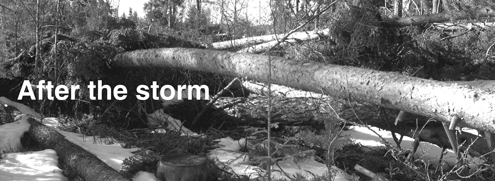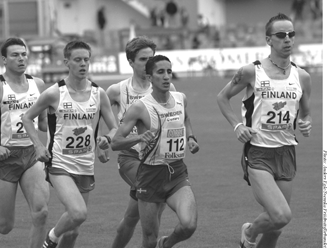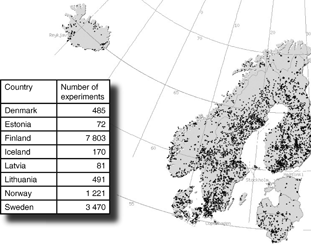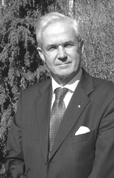No need to change Swedish forest policy, but there are lessons to learn

There is no need for drastic changes to Swedish forest policy in response to storm Gudrun, even though it had severe effects, blowing down 70 million cubic metres of forest in southern Sweden.
However, there is still a lot that the authorities can learn from the storm, in order to reduce the effects of future natural catastrophes.
The Swedish Forest Agency has analysed the effects of the storm in January 2005. More than an annual harvest was felled in a single night. The stormfelling was devastating for many forest owners. It also strained the whole forestry sector, affecting harvesting and transport logistics, timber storage, the timber market and the environment.
Economic, ecological and psychological consequences
The analysis shows that the overall economic consequences of the storm were less severe than expected, due to efficient processing of the stormfelled timber.
The ecological effects have been both positive and negative. The amount of dead wood has increased, and many areas with protected forest escaped the worst stormfelling. There is however a risk of leakage of mercury and nitrogen from the storm-felled areas.
The worst consequences of the storm were the physical and psychological injuries it caused to forest owners and forest workers, according to the Agency.
Lessons to learn
The are lessons to learn for the state authorities. The analysis bears the stamp of self-criticism. The advisory work must be more efficient, and provide greater help for forest owners to make their own decisions. There is great diversity in the values of the forest owners, which should lead to management practices being more diverse than if they were dictated by the authorities. This, in turn, is likely to reduce overall risks in the forestry sector, according to the analysis.
The analysis also concludes that current knowledge must be much better applied in forest management.
For example, early thinning and cleaning are known to be essential measures for creating windfirm stands, and should be more widely adopted.
Some other conclusions:
-
more resources are needed to monitor insects and wildlife stocks
-
there is an urgent need to study the leakage of nutrients, mercury and organic material from the forest and timber terminals
-
national preparedness plans for future natural catastrophes must be in place by 2008 at the latest
-
information on environmental effects, health and safety (including road safety) must be available for employees from other countries
-
temporary staff will be required to carry a license card-”a mini Green card”-showing that they too have sufficient knowledge of safe working practices, labour legislation, and environmental issues
-
insurance policies need to provide better cover for forest owners.
Source: www.svo.se
The CARS have left the starting grid
The four first CARS in the SNS fleet of advanced research centres have completed their first year. The centres were first presented in News and Views 1, 2005. Their first period in action is summarised here.
Under the auspices of SNS, a number of CARs (Virtual Centres of Advanced Research) have been appointed.
The main aims of the CARs are to promote synergies and avoid overlaps in R&D work, i.e. to use the total Nordic R&D resources as effectively as possible. Another important task is to attract external funding, e.g. from the EU.
The CARs function as “virtual centres” while the main research is carried out by their partners. The partners will fund their own activities, while the SNS grant will support the networking activities of the centre.
CARe-For-Us
The Nordic-Baltic Centre of Advanced Research on Forestry Serving Urbanised Societies
This centre has compiled detailed information on the current status of Nordic and Baltic urban forestry R&D, and identified research priorities.
The first steps towards creating a strategic framework and detailed work programme for networking within the CAR have also been taken.
More information can be found on the project's website:
The project leader is Dr Kjell Nilsson of the Danish Centre for Forest, Landscape and Planning.
The coordinator at the secretariat is Jasper Schipperijn, [email protected]
CAR-ES
The Centre of Advanced Research on Environmental Services
The centre has held its first meeting in H⊘rsholm, Denmark, and started to draw up integrated management options covering all three of its key environmental concerns (carbon sequestration, water protection and biodiversity). It has also planned a pilot review of buffer zones.
The project leader is Dr Per Gundersen of the Danish Centre for Forest, Landscape and Planning. [email protected]:
GENECAR
Nordic Centre for Advanced Research in Forest Gene-tics and Tree Breeding
Priorities set at a first meeting of this CAR in Biri, Norway, attended by 33 Nordic scientists, included (inter alia): to compile and disseminate information, to initiate research proposals, to utilise common materials and to coordinate common projects.
In addition, the centre initiated a project application which was granted by SNS (see News and Views 6, 2005). Three GENECAR members are also coordinators of the EU-coordinated initiative TREEBREEDEX.
Website:
The project leader is professor Tore Skr⊘ppa of the Norwegian Forest Research Institute. [email protected]
OSCAR
Operations Systems Centre of Advanced Research
This centre has held its first meetings and initiated two common projects:
-
Certification and standardisation of cargo loads on timber trucks.
-
Biofuel-adapted harvesting-a joint project between Latvia and Sweden.
The project leader is Dr Magnus Thor, Skogforsk (the Forestry Research Institute of Sweden). [email protected]
Finland versus Sweden

A recent benchmarking evaluation has identified the major similarities and differences between forestry in Finland and Sweden. The evaluation was initiated by their forest industries and will provide useful contextual information for ongoing forest policy discussions.
The Nordic forest industry is a major force in the international market; Sweden being the second, and Finland the third, largest exporters of forest-based products.
The forestry industries in Finland and Sweden may seem very similar at first glance, from an outsider's perspective. However, there are also significant differences between the two neighbouring countries, which may explain the differences in their standing in certain markets.
The evaluation was performed by staff from Metsäteho, Metla, and the Ministry of Agriculture and Forestry in Finland, and from Skogforsk in Sweden.
Some of the results:
-
The forest resources are quite similar, although slightly more abundant in Sweden.
-
There are many silvicultural similarities: regeneration methods are quite similar, although more direct seeding is used in Finland; both countries fertilize, scarifi y and pre-commercially thin similar acreages; and they use the same methods for tree breeding.
-
The ownership profi les differ somewhat. Family foresters predominate in Finland, and private companies are less important than in Sweden.
-
The industry structure differs. In Finland, a few major companies produce pulp, paper and sawn products. Finland also generates more high-value products. Sweden has more, but relatively smaller, forest industry companies.
-
The forestry is more tightly regulated in Sweden, e.g. in terms of rules concerning maximum clearcut areas, and requirements to produce plans for and descriptions of the forest.
-
The tax regime is more favourable for forest owners in Finland.
-
The forest sector receives more state support in Finland, and primarily for silvicultural aims, whereas government help largely supports conservation in Sweden.
-
Both countries invest about 1 Euro per harvested m3 in research, but Finland has moreforest researchers.
-
The forest sector is more profitable in Finland. The revenues from roundwood sales are higher in Finland, but the costs are approximately equal.
Contact: [email protected]
NOLTFOX – the database expands
NOLTFOX – the Nordic and Baltic database of long-term forest experiments – continues to grow. Last year, almost 2500 references concerning the experiments were added.
The total number of experiments included in the database is now (May 2006) almost 14,000. The database is open to the public, and it is possible to search the experiment-database by subject, objective, tree species, country or responsible organisation. It is also possible to limit searches to a certain geographical range, year of establishment, number of plots and treatments etc.
More information on http://noltfox.metla.fi
Shortcuts
Finn Jan Heino appointed FAO forestry director

Jan Heino, currently director of the state-owned forestry enterprise Metsähallitus, will start work as the Assistant Director General and head of the Forestry Department of the United Nations Food and Agriculture Organisation (FAO), and resign from Metsähallitus, at the end of June. He has previously acted as chairman of the Committee on Forestry, under the FAO. Heino's predecessor at the FAO was Hosny El-Lakany from Egypt, who retired earlier this year.
SNS board member new head of SLU

Professor Lisa Sennerby Forsse has been appointed the new head of SLU, the Swedish University of Agricultural Sciences. Lisa Sennerby Forsse is currently the secretary general of Formas, which is a governmental research-funding agency with responsibility for the environment, agricultural sciences and spatial planning. Lisa Sennerby Forsse is also a permanent member of the SNS board, and she has several international commitments.
Contact News & Views
Write to the scientifi c editor:
Mats Hannerz,
Skogforsk
SE-753 52 Uppsala
Sweden.
More info about SNS:
We strongly encourage our readers to contribute to a lively and interesting journal. Letters to the News & Views section will be published if they are:
-
short
-
relevant to the Journal
-
interesting for the readers.
News & Views is edited by
Mats Hannerz
and produced by
Carl Henrik Palmér. [email protected]